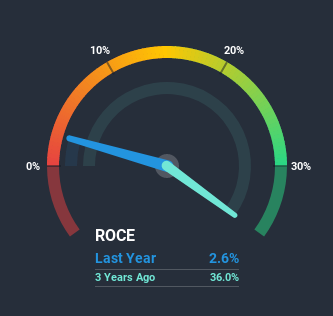- Hong Kong
- /
- Trade Distributors
- /
- SEHK:1891
Should We Be Excited About The Trends Of Returns At Heng Hup Holdings (HKG:1891)?

There are a few key trends to look for if we want to identify the next multi-bagger. Ideally, a business will show two trends; firstly a growing return on capital employed (ROCE) and secondly, an increasing amount of capital employed. Put simply, these types of businesses are compounding machines, meaning they are continually reinvesting their earnings at ever-higher rates of return. Having said that, from a first glance at Heng Hup Holdings (HKG:1891) we aren't jumping out of our chairs at how returns are trending, but let's have a deeper look.
Return On Capital Employed (ROCE): What is it?
For those who don't know, ROCE is a measure of a company's yearly pre-tax profit (its return), relative to the capital employed in the business. The formula for this calculation on Heng Hup Holdings is:
Return on Capital Employed = Earnings Before Interest and Tax (EBIT) ÷ (Total Assets - Current Liabilities)
0.026 = RM4.8m ÷ (RM206m - RM23m) (Based on the trailing twelve months to June 2020).
Thus, Heng Hup Holdings has an ROCE of 2.6%. In absolute terms, that's a low return and it also under-performs the Trade Distributors industry average of 5.4%.
View our latest analysis for Heng Hup Holdings

While the past is not representative of the future, it can be helpful to know how a company has performed historically, which is why we have this chart above. If you want to delve into the historical earnings, revenue and cash flow of Heng Hup Holdings, check out these free graphs here.
What The Trend Of ROCE Can Tell Us
In terms of Heng Hup Holdings' historical ROCE movements, the trend isn't fantastic. Around four years ago the returns on capital were 32%, but since then they've fallen to 2.6%. Given the business is employing more capital while revenue has slipped, this is a bit concerning. If this were to continue, you might be looking at a company that is trying to reinvest for growth but is actually losing market share since sales haven't increased.
On a side note, Heng Hup Holdings has done well to pay down its current liabilities to 11% of total assets. So we could link some of this to the decrease in ROCE. What's more, this can reduce some aspects of risk to the business because now the company's suppliers or short-term creditors are funding less of its operations. Since the business is basically funding more of its operations with it's own money, you could argue this has made the business less efficient at generating ROCE.The Key Takeaway
We're a bit apprehensive about Heng Hup Holdings because despite more capital being deployed in the business, returns on that capital and sales have both fallen. In spite of that, the stock has delivered a 1.7% return to shareholders who held over the last year. Regardless, we don't like the trends as they are and if they persist, we think you might find better investments elsewhere.
One final note, you should learn about the 4 warning signs we've spotted with Heng Hup Holdings (including 1 which is is significant) .
For those who like to invest in solid companies, check out this free list of companies with solid balance sheets and high returns on equity.
If you’re looking to trade Heng Hup Holdings, open an account with the lowest-cost* platform trusted by professionals, Interactive Brokers. Their clients from over 200 countries and territories trade stocks, options, futures, forex, bonds and funds worldwide from a single integrated account. Promoted
Valuation is complex, but we're here to simplify it.
Discover if Heng Hup Holdings might be undervalued or overvalued with our detailed analysis, featuring fair value estimates, potential risks, dividends, insider trades, and its financial condition.
Access Free AnalysisThis article by Simply Wall St is general in nature. It does not constitute a recommendation to buy or sell any stock, and does not take account of your objectives, or your financial situation. We aim to bring you long-term focused analysis driven by fundamental data. Note that our analysis may not factor in the latest price-sensitive company announcements or qualitative material. Simply Wall St has no position in any stocks mentioned.
*Interactive Brokers Rated Lowest Cost Broker by StockBrokers.com Annual Online Review 2020
Have feedback on this article? Concerned about the content? Get in touch with us directly. Alternatively, email editorial-team@simplywallst.com.
About SEHK:1891
Heng Hup Holdings
An investment holding company, engages in the trading of scrap ferrous metal in Malaysia.
Solid track record with adequate balance sheet.
Market Insights
Community Narratives



